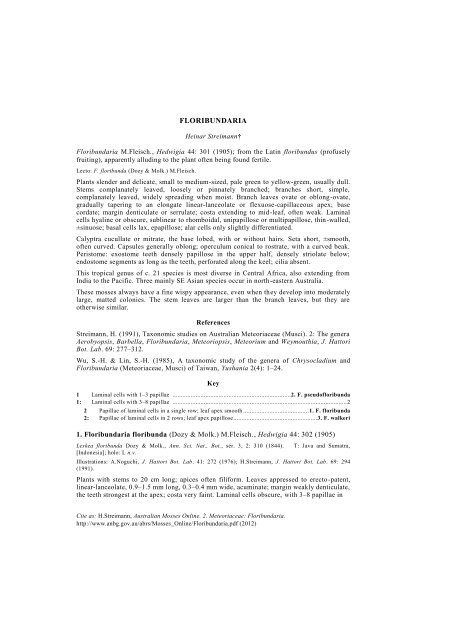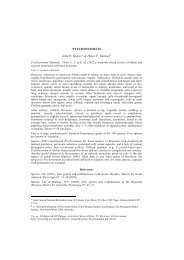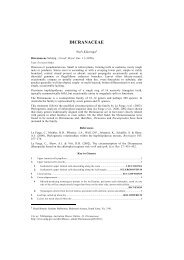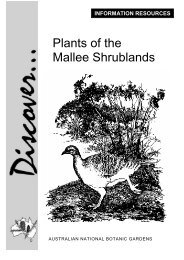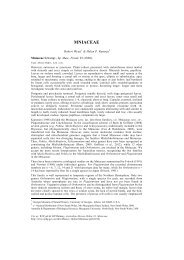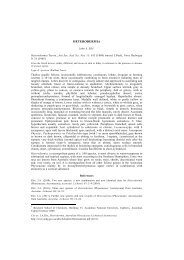FLORIBUNDARIA 1. Floribundaria floribunda (Dozy & Molk.) M ...
FLORIBUNDARIA 1. Floribundaria floribunda (Dozy & Molk.) M ...
FLORIBUNDARIA 1. Floribundaria floribunda (Dozy & Molk.) M ...
Create successful ePaper yourself
Turn your PDF publications into a flip-book with our unique Google optimized e-Paper software.
<strong>FLORIBUNDARIA</strong><br />
Heinar Streimann†<br />
<strong>Floribundaria</strong> M.Fleisch., Hedwigia 44: 301 (1905); from the Latin floribundus (profusely<br />
fruiting), apparently alluding to the plant often being found fertile.<br />
Lecto: F. <strong>floribunda</strong> (<strong>Dozy</strong> & <strong>Molk</strong>.) M.Fleisch.<br />
Plants slender and delicate, small to medium-sized, pale green to yellow-green, usually dull.<br />
Stems complanately leaved, loosely or pinnately branched; branches short, simple,<br />
complanately leaved, widely spreading when moist. Branch leaves ovate or oblong-ovate,<br />
gradually tapering to an elongate linear-lanceolate or flexuose-capillaceous apex; base<br />
cordate; margin denticulate or serrulate; costa extending to mid-leaf, often weak. Laminal<br />
cells hyaline or obscure, sublinear to rhomboidal, unipapillose or multipapillose, thin -walled,<br />
±sinuose; basal cells lax, epapillose; alar cells only slightly differentiated.<br />
Calyptra cucullate or mitrate, the base lobed, with or without hairs. Seta short, ±smooth,<br />
often curved. Capsules generally oblong; operculum conical to rostrate, with a curved beak.<br />
Peristome: exostome teeth densely papillose in the upper half, densely striolate below;<br />
endostome segments as long as the teeth, perforated along the keel; cilia absent.<br />
This tropical genus of c. 21 species is most diverse in Central Africa, also extending from<br />
India to the Pacific. Three mainly SE Asian species occur in north-eastern Australia.<br />
These mosses always have a fine wispy appearance, even when they develop into moderately<br />
large, matted colonies. The stem leaves are larger than the branch leaves, but they are<br />
otherwise similar.<br />
References<br />
Streimann, H. (1991), Taxonomic studies on Australian Meteoriaceae (Musci). 2: The genera<br />
Aerobyopsis, Barbella, <strong>Floribundaria</strong>, Meteoriopsis, Meteorium and Weymouthia, J. Hattori<br />
Bot. Lab. 69: 277–312.<br />
Wu, S.-H. & Lin, S.-H. (1985), A taxonomic study of the genera of Chrysocladium and<br />
<strong>Floribundaria</strong> (Meteoriaceae, Musci) of Taiwan, Yushania 2(4): 1–24.<br />
Key<br />
1 Laminal cells with 1–3 papillae ........................................................................2. F. pseudo<strong>floribunda</strong><br />
1: Laminal cells with 3–8 papillae .......................................................................................................... 2<br />
2 Papillae of laminal cells in a single row; leaf apex smooth ........................................ <strong>1.</strong> F. <strong>floribunda</strong><br />
2: Papillae of laminal cells in 2 rows; leaf apex papillose ................................................... 3. F. walkeri<br />
<strong>1.</strong> <strong>Floribundaria</strong> <strong>floribunda</strong> (<strong>Dozy</strong> & <strong>Molk</strong>.) M.Fleisch., Hedwigia 44: 302 (1905)<br />
Leskea <strong>floribunda</strong> <strong>Dozy</strong> & <strong>Molk</strong>., Ann. Sci. Nat., Bot., sér. 3, 2: 310 (1844). T: Java and Sumatra,<br />
[Indonesia]; holo: L n.v.<br />
Illustrations: A.Noguchi, J. Hattori Bot. Lab. 41: 272 (1976); H.Streimann, J. Hattori Bot. Lab. 69: 294<br />
(1991).<br />
Plants with stems to 20 cm long; apices often filiform. Leaves appressed to erecto-patent,<br />
linear-lanceolate, 0.9–<strong>1.</strong>5 mm long, 0.3–0.4 mm wide, acuminate; margin weakly denticulate,<br />
the teeth strongest at the apex; costa very faint. Laminal cells obscure, with 3–8 papillae in<br />
Cite as: H.Streimann, Australian Mosses Online. 2. Meteoriaceae: <strong>Floribundaria</strong>.<br />
http://www.anbg.gov.au/abrs/Mosses_Online/<strong>Floribundaria</strong>.pdf (2012)
egular rows over each cell from the acumen almost to the base, sublinear to hexagonal;<br />
acumen cells to 20–50 × 2 µm; upper and median cells ±sigmoid, to 50 × 5 µm; a few basal<br />
corner cells thicker-walled, c. 20 × 10 µm.<br />
Calyptra cucullate c. <strong>1.</strong>5 mm long, sparsely hairy. Seta blackish brown, 2.0–2.5 (–4.0) mm<br />
long, often curved. Capsules ovate-oblong, c. <strong>1.</strong>8 mm long and 0.8 mm wide; operculum c. 1<br />
mm long, conical-rostrate, with a long beak. Peristome: exostome teeth and endostome<br />
segments c. 0.5 mm long; segments broader. Spores 15–22 (–25) µm diam.<br />
Occurs in north-eastern Qld, where it is rare on trees and shrubs in tropical rainforest, mainly<br />
at altitudes of 400–1200 m. Also known from southern Africa, through Asia and the Pacific<br />
to Brazil.<br />
Qld: Mt Lewis, c. 100 NW of Cairns, B.O. van Zanten 681368A (GRO); Topaz Rd, 13 km SE of Malanda,<br />
H.Streimann 46686 (Musci Austral. Exs. 29) (CANB); Palmerston Natl Park, I.G.Stone 15133 (MELU).<br />
Stem leaves differ from branch leaves in having entire margins and long, often filiform<br />
apices, slightly broader median cells and more pronounced cell margins.<br />
2. <strong>Floribundaria</strong> pseudo<strong>floribunda</strong> M.Fleisch., Musc. Buitenzorg 3: 822 (1908)<br />
T: M.Fleischer, Musc. Archip. Ind. et Polynes. No. 435; holo: FH n.v.<br />
Illustrations: A.Noguchi, J. Hattori Bot. Lab. 41: 276 (1976); D.H.Norris & T.Koponen, Acta Bot. Fenn. 131:<br />
37 (1985); H.Streimann, J. Hattori Bot. Lab. 69: 296 (1991).<br />
Plants slightly glossy; stems to 4 cm long; branches <strong>1.</strong>0–<strong>1.</strong>5 mm long. Branch and stem<br />
leaves spreading when dry or moist. Branch leaves lanceolate or, rarely, ovate-oblong,<br />
usually c. <strong>1.</strong>6 × 0.4 mm, short-acuminate or narrowly acute; margin serrulate; costa faint,<br />
scarcely reaching mid-leaf, pale brown. Laminal cells obscure, with 1 (or 2) papillae per cell;<br />
apical and upper cells sigmoid, to 50 × 7 µm; median cells sigmoid, to 37 × 4 µm; base<br />
occasionally with 1 large yellowish alar cell, elliptic to ovate, 25 × 20 µm.<br />
Calyptra cucullate, c. <strong>1.</strong>5 mm long, hairy. Seta smooth, <strong>1.</strong>5–<strong>1.</strong>8 mm long. Capsules oblong,<br />
<strong>1.</strong>5–2.0 mm long, brownish. Peristome: exostome teeth and endostome segments 0.40–0.45<br />
mm long. Spores not seen.<br />
Rare in north-eastern Qld. Also from India to SE Asia, Taiwan, Japan, and from Malesia to<br />
Vanuatu and the Hawaiian Islands.<br />
Qld: Mossman Gorge, I.G.Stone 23166 (MELU); near Ravenshoe, W.W.Watts Q624 (H, NSW); Woopen Ck,<br />
I.G.Stone 18176A (MELU).<br />
3. <strong>Floribundaria</strong> walkeri (Renauld & Cardot) Broth., in H.G.A.Engler & K.A.E.Prantl,<br />
Nat. Pflanzenfam. I, 3: 822 (1906)<br />
Papillaria walkeri Renauld & Cardot, Bull. Soc. Roy. Bot. Belgique 34(2): 70 (1896). T: Kurseong<br />
[Edentale Plantation], Darjeeling, [India], Nov. 1893, Walker; holo: PC n.v.<br />
Illustrations: A.Noguchi, J. Hattori Bot. Lab. 41: 274 (1976); S.-H.Wu & S.-H.Lin, Yushania 2(4): 18 (1985);<br />
H.Streimann, J. Hattori Bot. Lab. 69: 298 (1991).<br />
Plants small, sparsely leaved, to 4 cm long. Branches few, simple, their upper part slender<br />
and capillaceous. Stem leaves ovate-lanceolate, to <strong>1.</strong>5 mm long and 0.5 mm wide, with a<br />
long-acuminate apex. Branch leaves narrowly lanceolate, 0.9–<strong>1.</strong>3 mm long, 0.2–0.6 mm<br />
wide, broadest near the base; apex narrowly attenuate; margin plane, serrulate, with<br />
projecting cells; costa faint. Apical, upper and median laminal cells with small papillae in c.<br />
2 rows, ±obscure, (20–) 50 × 2–4 (–7) µm; median cells 37–50 × 2–4 µm; basal cells shorter<br />
and broader, hexagonal near the costa, 50–75 × 3–5 (–12) µm, with the papillae more<br />
prominent; alar cells absent.<br />
Sporogones not known from Australia.<br />
Rare in north-eastern Qld; also reported from South Africa, Madagascar, India, Sri Lanka<br />
and from SE Asia to Samoa.<br />
Qld: track to Majors Falls, Ravenshoe, W.W.Watts Q579 (H, NSW); Yungaburra, W.W.Watts Q668 (H, NSW).


